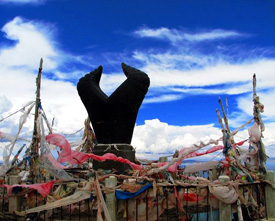Maduo Town
 Why not start your journey into Tibet by literally starting it at the beginning of one of the life sources for millions of people? Maduo, which translates to “the source of the Yellow River”, is widely regarded as the cradle of Chinese culture. It is located in the Qinghai Province, one of the oldest areas of Tibet, and is about 500 kilometers (310 miles) southwest of Xining, the province of the capital city Lhasa. Maduo is the first big stop inland when traveling from China.
Why not start your journey into Tibet by literally starting it at the beginning of one of the life sources for millions of people? Maduo, which translates to “the source of the Yellow River”, is widely regarded as the cradle of Chinese culture. It is located in the Qinghai Province, one of the oldest areas of Tibet, and is about 500 kilometers (310 miles) southwest of Xining, the province of the capital city Lhasa. Maduo is the first big stop inland when traveling from China.
Arriving in the town is like taking a journey back in time. Maduo surrounded by a completely nomadic lifestyle and run mainly by sheep and yak farmers. While the recently built sections of the town feature more modern amenities, don’t expect a 5-Star stay in Maduo. Your trip here is about taking in life as it used to be hundreds of years ago. It will make for an experience like none other.
Sitting at over 4300 meters (14,000 feet), high, Maduo is one of the highest and coldest areas in Tibet. Temperatures here can vary wildly during the year. Known for harsh winters, it is best to keep your travels to Maduo during the late spring, summer or early fall months. While snow can fall any day of the year, coming during the warmer months will ensure that no weather conditions will keep you from seeing all that this beautiful area has to offer.
Take note of the possibility of altitude sickness as well. Because of the staggering heights here, many guests are not used to the thin air’s effects. A local resident doctor is available in town for western medicines and on call to refill oxygen tanks if needed.
When in Maduo, be sure to take the time to enjoy the majesty of the surrounding bodies of water. Several thousand lakes make up the source of the Yellow River. Crystal-clear waters sparkle in every direction. The most famous of the lakes are Eling Lake and Zhaling Lake. With awe-inspiring landscapes and pristine waters, these two are not to be missed when in Maduo. Ngoring Tso and Kyaring Tso are also known for their breathtaking beauty. While these might take an extra day to travel to, they are definitely worth the visit. Additionally, there is a small monastery in the east part of town perched up on a hill. This quaint religious site is often dotted with prayer flags and is a great introduction to Tibetan Buddhist monasteries.
There are extensive bus lines constantly running from Xining to all areas of Qinghai. The roads are well maintained and give visitors a great opportunity to see vast amount of unbelievable Tibetan countryside and possibly spot wildlife such as Tibetan antelopes, fire foxes and large groups of migratory birds. There are several options when arriving in Xining. The province is fairly accessible by plane or train and from there you can easily venture out to other parts of the country.